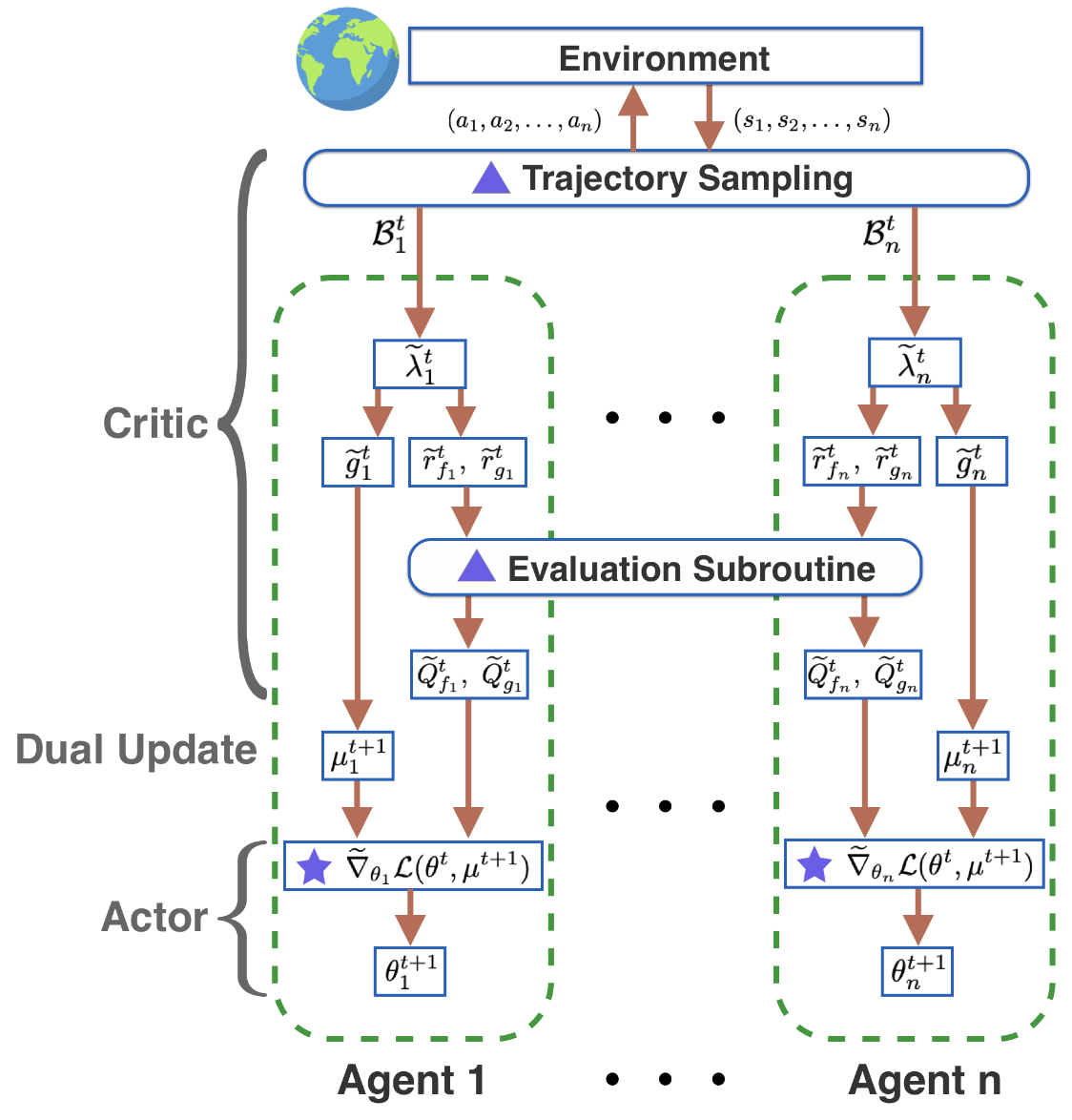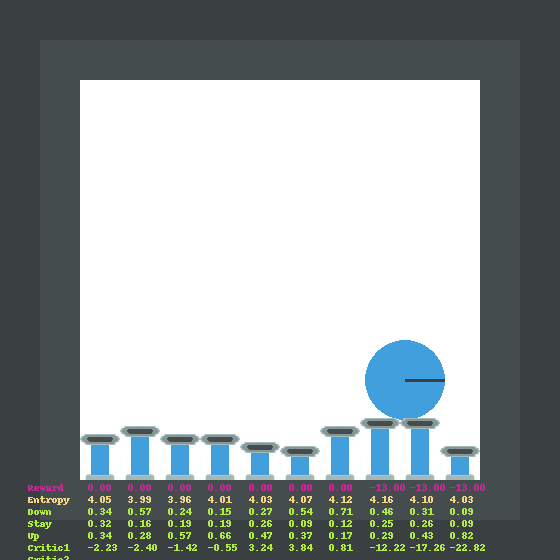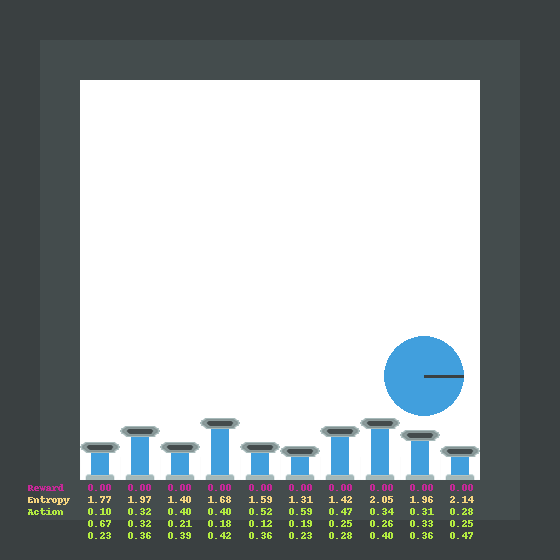Scalable Primal-Dual Actor-Critic Method for Safe Multi-Agent Reinforcement Learning with General Utilities (NeurIPS 2023)
Authors: Donghao Ying, Yunkai Zhang, Yuhao Ding, Alec Koppel, and Javad Lavaei.
If you find this repo useful, please cite our paper.
@inproceedings{ying2023Scalable,
title={Scalable Primal-Dual Actor-Critic Method for Safe Multi-Agent Reinforcement Learning with General Utilities},
author={Donghao Ying and Yunkai Zhang and Yuhao Ding and Alec Koppel and Javad Lavaei},
booktitle={Advances in Neural Information Processing Systems},
year={2023}
}
We investigate safe multi-agent reinforcement learning, focusing on the setting where
- each agent is associated with a local objective function and a local constraint function, defined by general utilities;
- each agent only has access to the observation/action/Q-function of other agents that are within its
$\kappa$ -hop neighborhood; - the agents aim at jointly maximizing the aggregate sum of local objectives while satisfying their own safety constraints.
Our main contribution is the development of a scalable algorithm with theoretical guarantees. We also performed numerical experiments to validate the proposed algorithm.
In view of the challenges presented by global observation/communication in large networks, we focus on the setting of distributed training without global observability. Our technical contributions are summarized as follows:
- Compared with existing theoretical works on safe MARL (Lu et al., 2021, Mondal et al., 2022, Gu et al., 2022), we present the first safe MARL formulation that extends beyond cumulative forms in both the objective and constraints. We develop a truncated policy gradient estimator utilizing shadow reward and
$\kappa$ -hop policies under a form of correlation decay property, where$\kappa$ represents the communication radius. The approximation errors arising from both policy implementation and value estimation are quantified. - Despite of the global coupling of agents' local utility functions, we propose a scalable Primal-Dual Actor-Critic method, which allows each agent to update its policy based only on the states and actions of its close neighbors and under limited communications. The effectiveness of the proposed algorithm is verified through numerical experiments.
- From the perspective of optimization, we devise new tools to analyze the convergence of the algorithm. In the exact setting, we establish an
$\mathcal{O}\left(T^{-2/3}\right)$ convergence rate for finding an FOSP, matching the standard convergence rate for solving nonconcave-convex saddle point problems. In the sample-based setting, we prove that, with high probability, the algorithm requires$\widetilde{\mathcal{O}}\left(\epsilon^{-3.5}\right)$ samples to obtain an$\epsilon$ -FOSP with an approximation error of$\mathcal{O}(\phi_0^{2\kappa})$ , where$\phi_0\in (0,1)$ .
It allows us to define a wider range of objectives/constraints, such as imitation learning and pure exploration (Zhang et al., 2020, Zhang et al., 2022). Designing similar constraints with traditional cumulative rewards can be hard, and sometimes even not possible (Zahavy et al., 2021). We provide a numerical example to demonstrate the convenience of using general utilities in Appendix H.5.
- Synthetic Environment:
- Agents form a 1D linear interation graph and needs to pass a state from right to left.
- The environment code is ./envs/linemsg.py and the corresponding training code is main_synthetic.py.
- Pistonball:
- A modification of the original Pistonball environment to highlight the decentralized MARL with safety constraint setting.
- The game has a high-dimensional state space and involves complex physics-based transition dynamics.
- Each piston only has access to the piston heights in its kappa-hop neighborhood and can only access the ball's information if the ball enters the neighborhood.
- The environment code is in ./envs/pistonball and the corresponding training code is main_piston.py.
- Wireless Communication:
- As there are more agents than access points, some agents must learn to make sacrifices in order to maximize the overall objective.
- We enforce an apprenticeship learning constraint by encouraging more deterministic actions from the agents in order to improve their coordination.
- The environment code is in ./envs/wireless_comm.py and the corresponding training code is main_wireless.py.
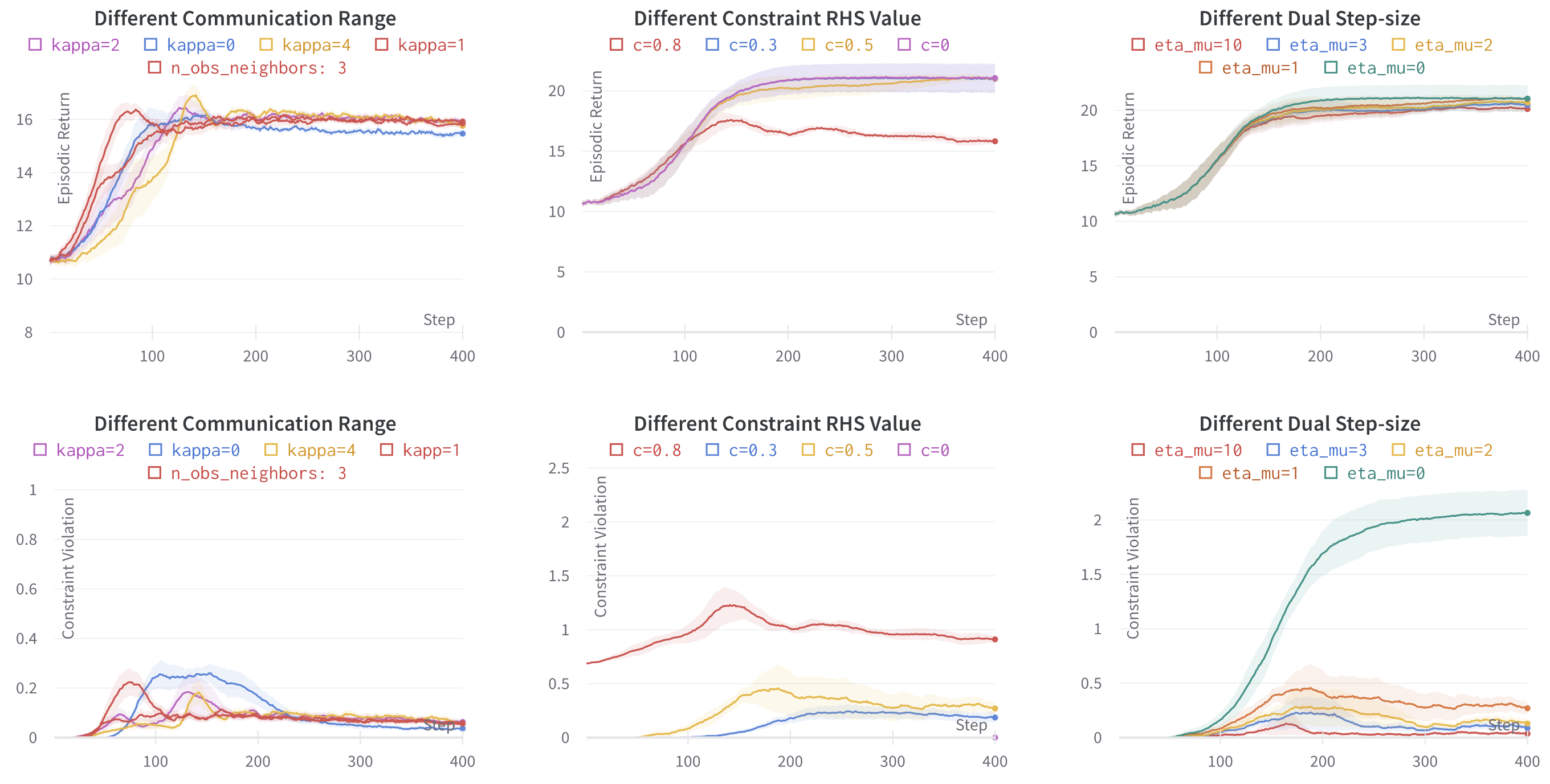
Performance in the synthetic environment with 10 agents under entropy constraints. Left: different communication ranges. Middle: different constraint right-hand side (RHS) values. Right: different dual step-sizes.
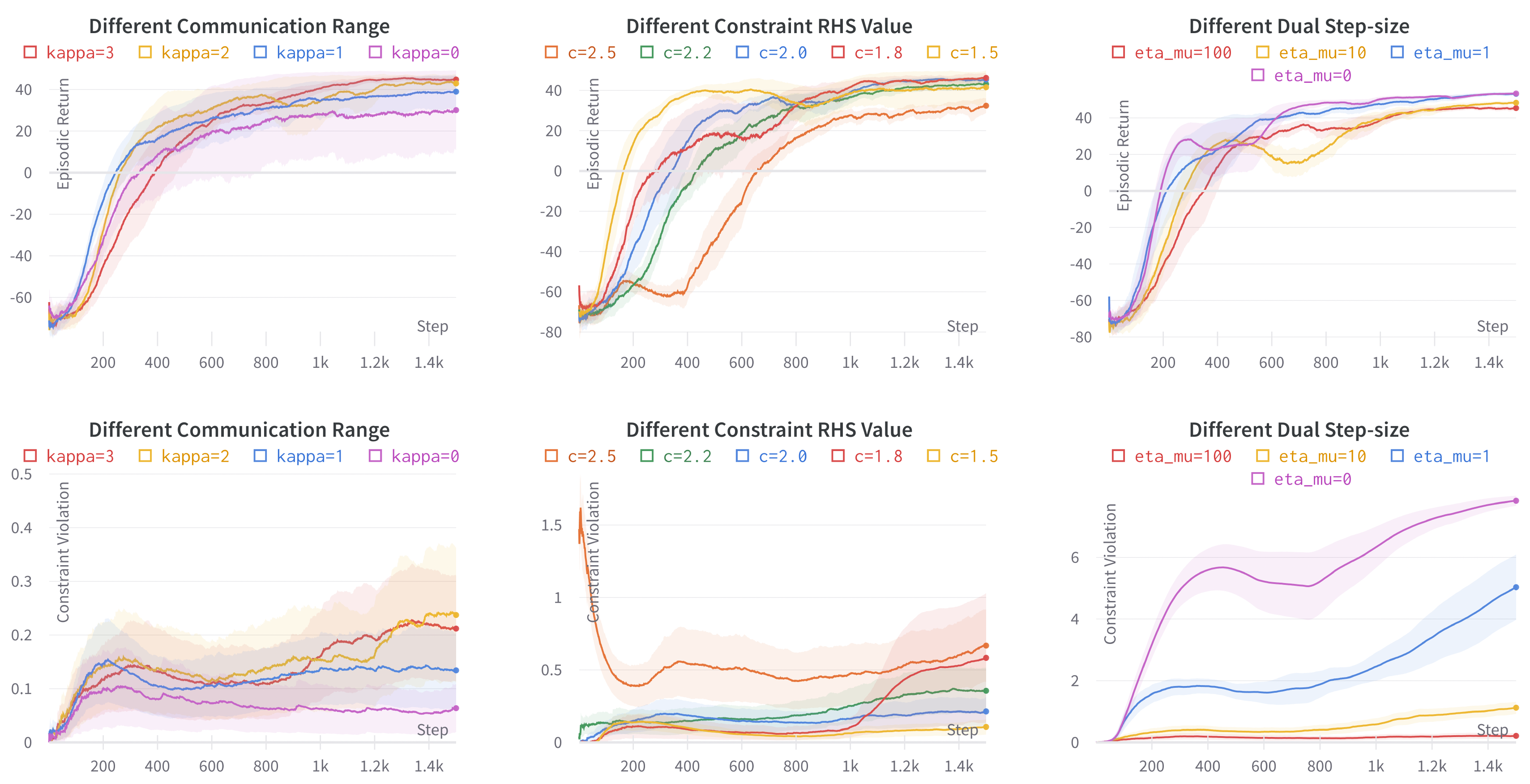
Performance of in the Pistonball environment with 10 agents under entropy constraints. Left: different communication ranges. Middle: different constraint RHS values. Right: different dual step-sizes. The total constraint violation is defined as the sum of absolute violations for each local constraints.
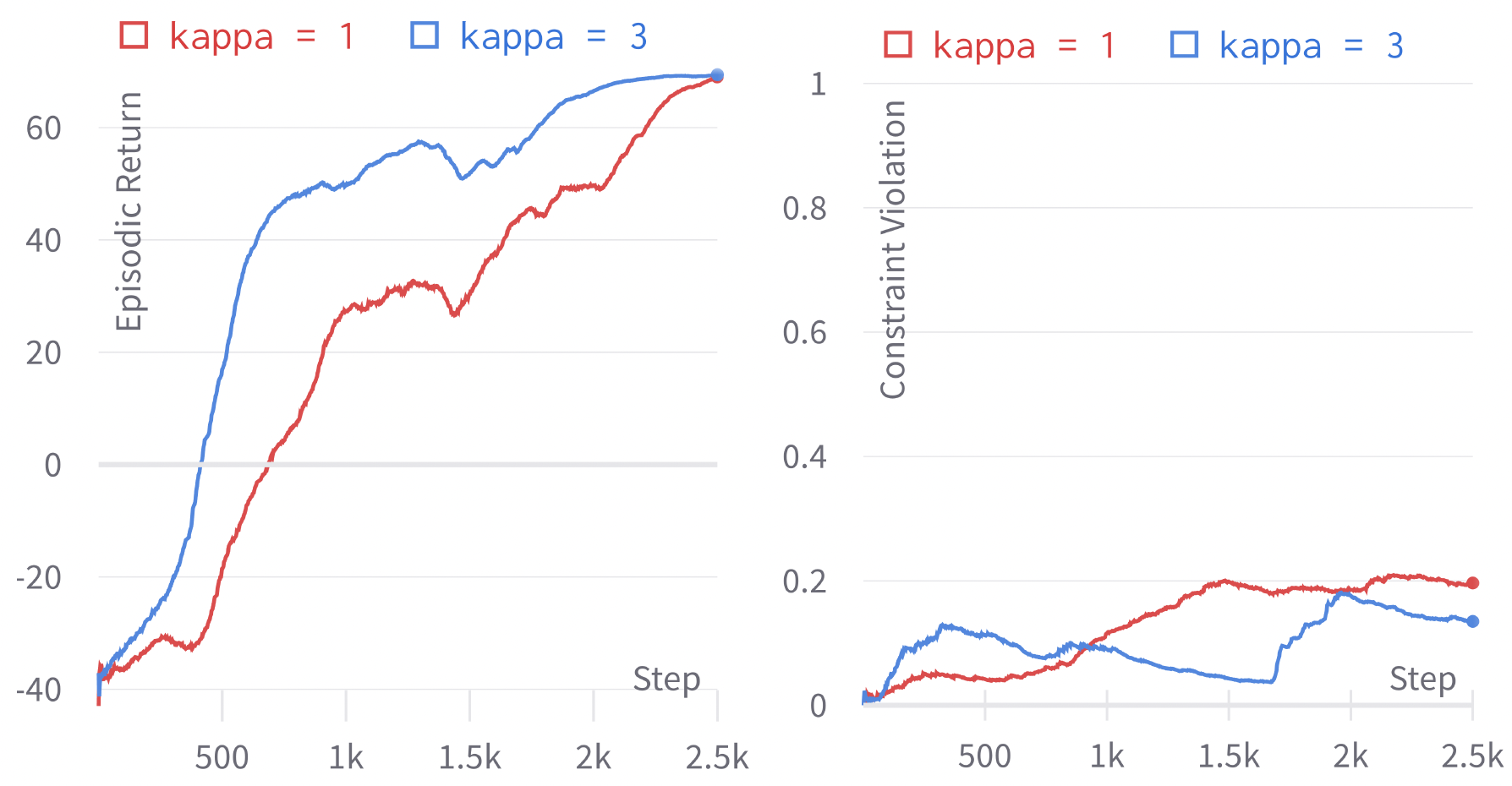
Performance of in the Pistonball environment with 20 agents under entropy constraints with different communication range. Left: episodic return. Right: constraint violation.
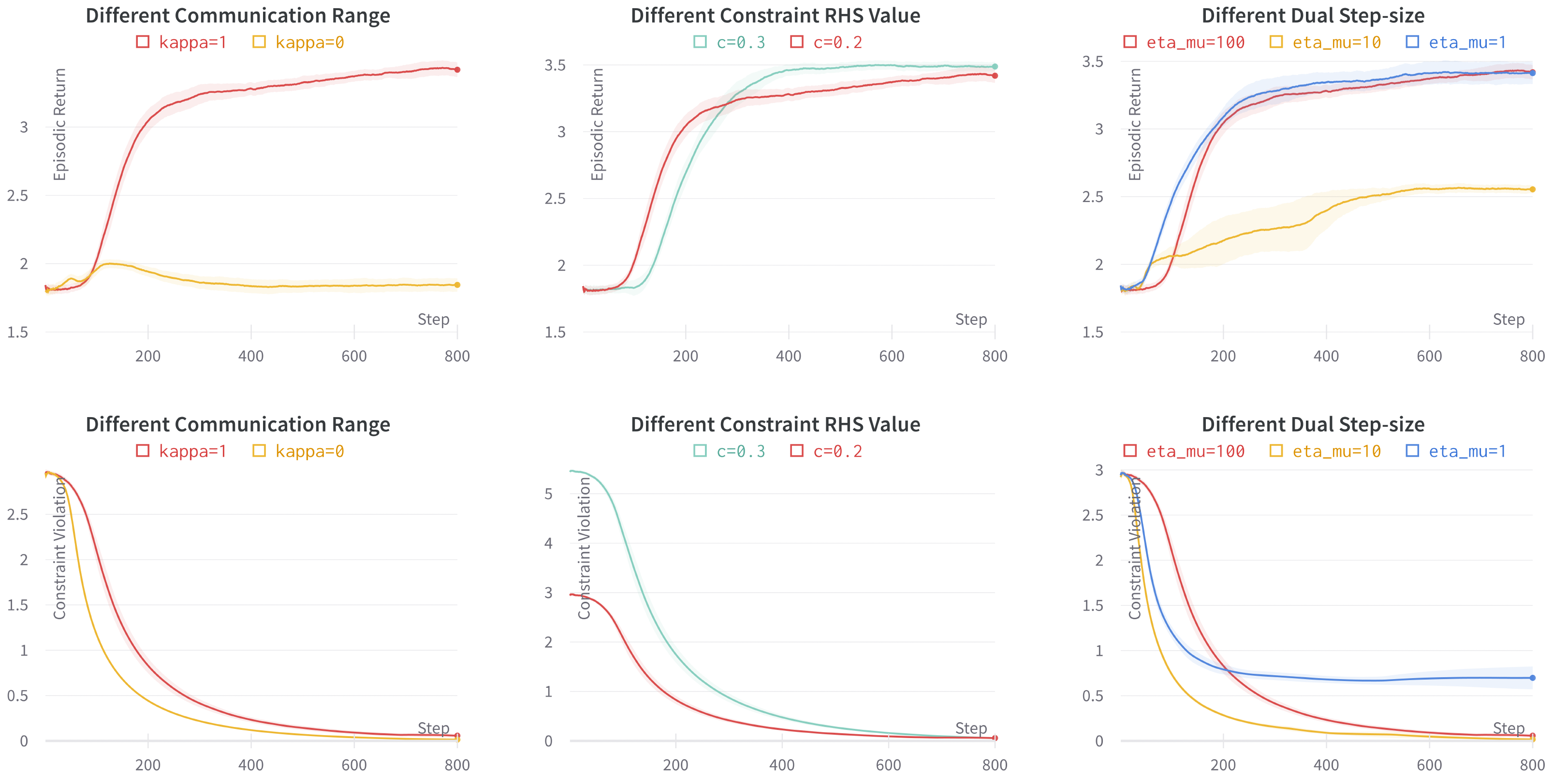
Performance of in the Wireless Communication environment with 25 agents under an apprenticeship learning constraints. Left: different communication ranges. Middle: different constraint RHS values. Right: different dual step-sizes.
We cannot directly compare our method with existing approaches like MAPPO-Lagrangian (MAPPO-L), as we allow the objective and constraints to take the form of general utilities.
For a fair comparison, we consider two standard safe MARL problems, where both objectives and constrains are defined using traditional cumulative rewards.
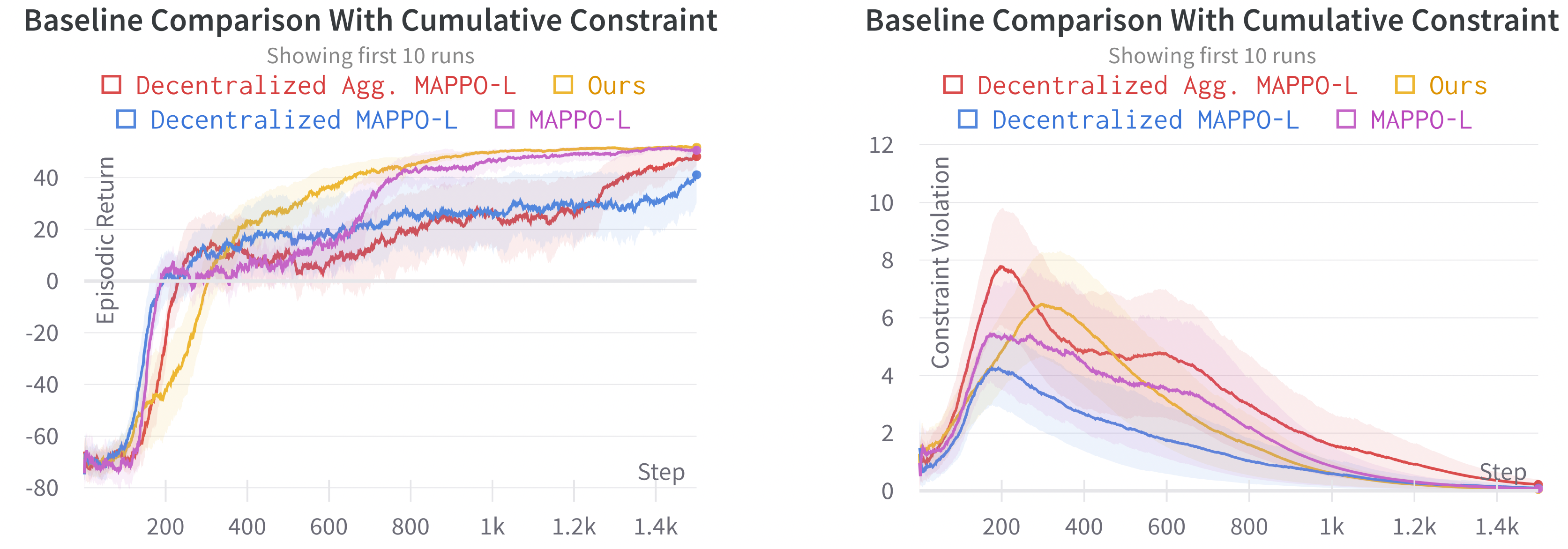
Comparison between Scalable Primal-Dual Actor-Critic method in our work with MAPPO-L and its variants in Pistonball, where the new constraint is to keep the agents away from high positions.
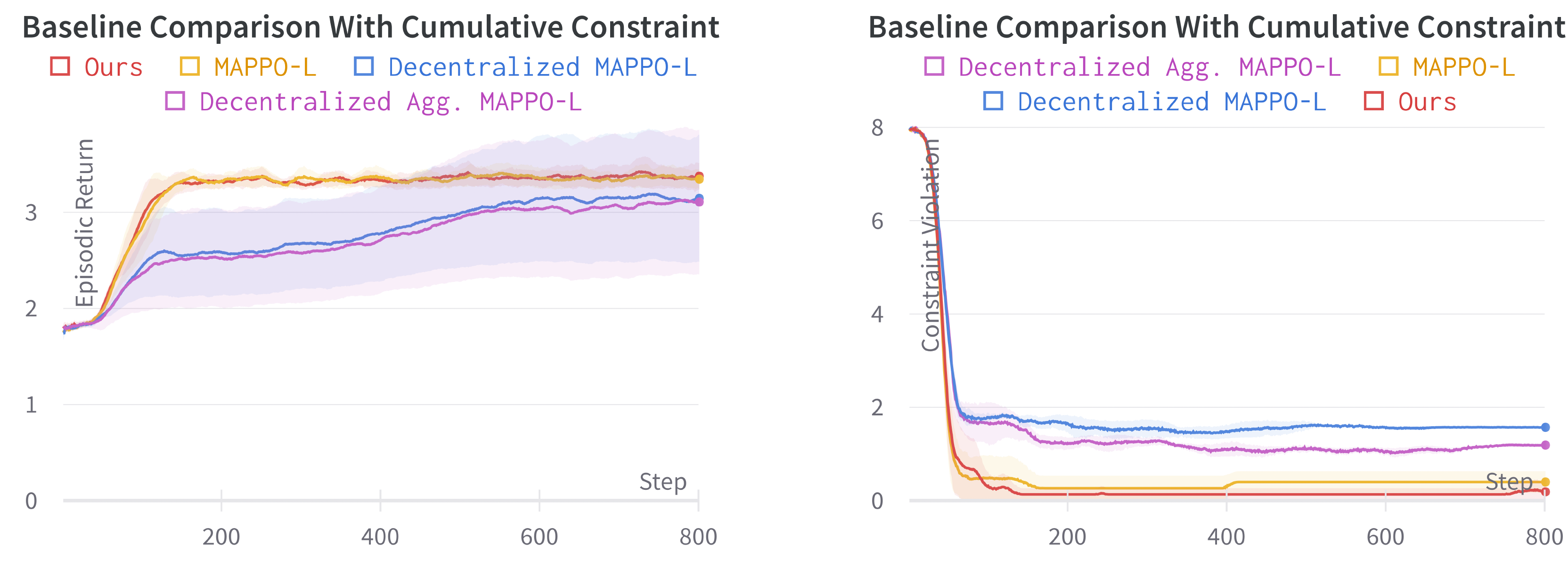
Comparison between Scalable Primal-Dual Actor-Critic method in our work with MAPPO-L and its variants in wireless communication, where the new constraint is to enforce the agent to only transmit packages when necessary.
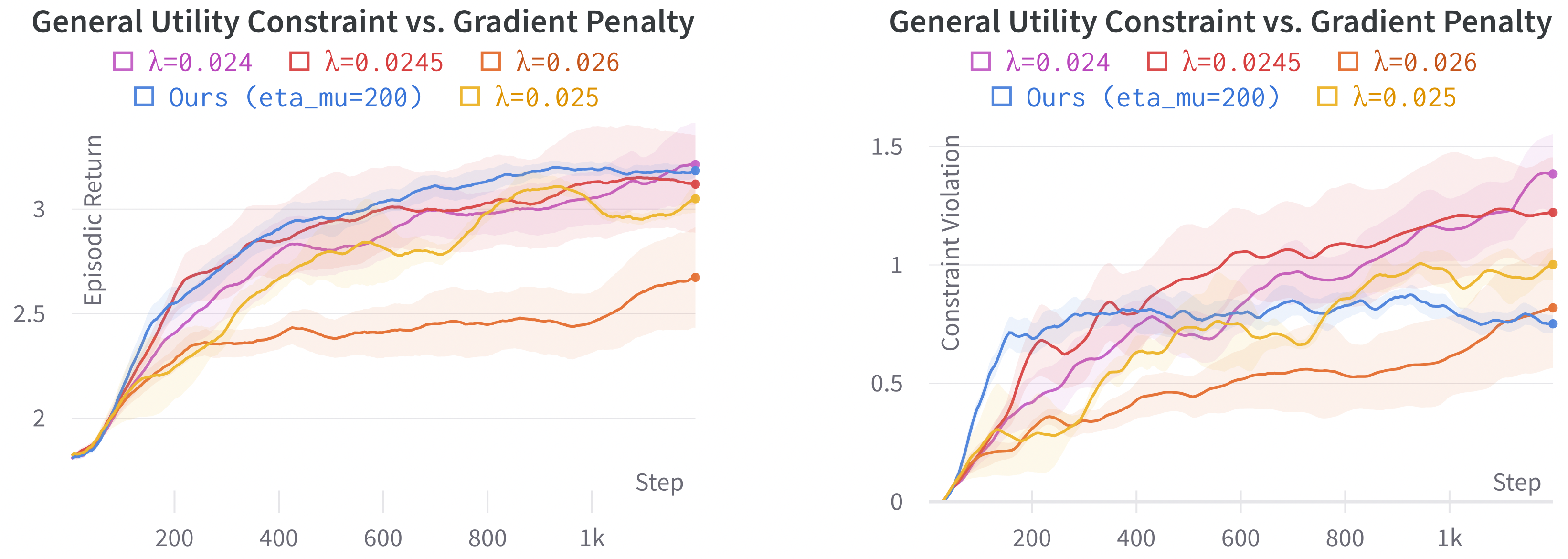
We focus on a scenario where the constraint conflicts with the objective. We compare with a gradient penalty approach to encourage entropy.
Effective Cooperation. In this figure, agents' positions are initialized randomly at the beginning. To facilitate the ball’s leftward movement, agent 1 must move upwards, while agent 2 should move downwards. This is confirmed by a high upward probability of agent 1 and a high downward probability of agent 2. Later in the process, agents 1 − 4 have created a slope for the ball to move leftward rapidly. After the ball passes, we can see that the upward probabilities of agents 1 − 4 are very close to one, meaning that they move upwards to eliminate the possibility of the ball moving back to the right. However, agents 8 − 10 still obstruct the ball’s path, as they have not detected the arrival of the ball due to the limited communication range and move mostly randomly to satisfy the entropy constraint. Finally, we observe that when the ball approaches, the downward probabilities of agents 9 − 10 become one, and the upward probabilities of agents 5 − 8 also increase to one.
Learned to Sacrifice.
In this figure, we observe that agents 1 − 3 decide to move the ball all the way up. Despite incurring a time penalty
for themselves, this provides more flexibility for agent 4, allowing more time to take random actions in order to
satisfy the safety constraint. This happens because during training, the proposed algorithm performs policy update
by directly incorporating the Q-functions of all agents in its
Optimized for the Common Goal. In the Wireless Communication environment, explicitly encouraging a deterministic policy allows other agents to better predict the agent's next moves and thus avoid collisions. In this figure, we see that due to the added apprenticeship learning constraint, the agents learn to take more deterministic actions so that their actions are more predictable for their neighbors. Remarkably, the agents are able to collaboratively identify a plan so that each access point is only used by one agent in order to avoid collision. Being able to achieve this requires much collaboration, coordination, and logical reasoning among the agents.
-
Install required packages.
conda create -n cdsac python=3.9 conda activate cdsac pip install gym==0.23.1 wandb SuperSuit==3.8.0 pettingzoo==1.23.0 torch==1.13.1 opencv-python Pillow tensorboard tqdm pytz pygame pymunk
-
Start training. See the beginning of 'main' for a list of arguments it takes.
python3 main_piston.py
-
To sync the results via wandb:
python3 main_piston.py --track
-
To visualize the outputs:
python3 main_piston.py --track --debug
